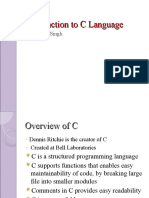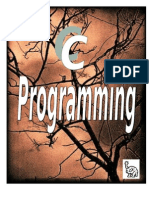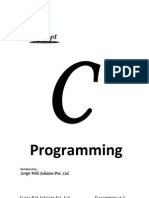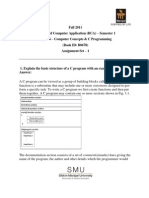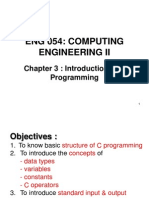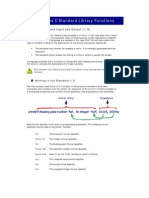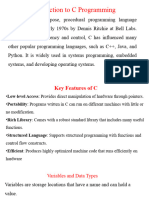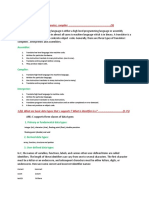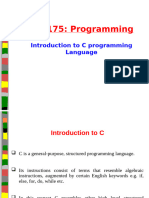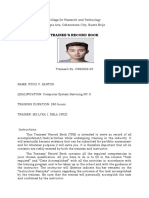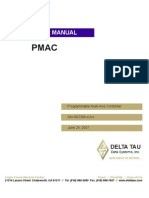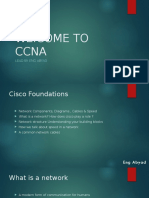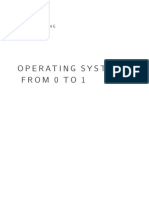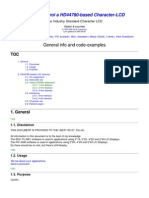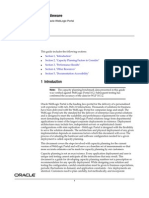General Elements of A C Program
General Elements of A C Program
Uploaded by
Sundar GuyahCopyright:
Available Formats
General Elements of A C Program
General Elements of A C Program
Uploaded by
Sundar GuyahOriginal Description:
Original Title
Copyright
Available Formats
Share this document
Did you find this document useful?
Is this content inappropriate?
Copyright:
Available Formats
General Elements of A C Program
General Elements of A C Program
Uploaded by
Sundar GuyahCopyright:
Available Formats
UNIVERSITY OF TECHNOLOGY, JAMAICA
SCHOOL OF COMPUTING & INFORMATION TECHNOLOGY Programming 1 General Elements of a C Program The C Programming Language Character Sets C does not use nor require the use of every character. It uses the following: A-Z, a-z, 0-9, . : ; $ # % & ! _ {} [] () <> | + - / * = C Form C is considered to be a function language, thus all C programs will consist of at least one function. It uses only 32 key words, which combine with the formal syntax to form the programming language. C is case sensitive and all keywords are lower case. Layout of Programs The general form of a C program is as follows: Preprocessor directives Function prototypes Global declarations /* comments */ main() { Local variables and function names; //comment Statements associated to main; } f1() { Local variables to function_f1; Statements associated with function_f1; } f2() { Local variables to function_f2; Statements associated with function_f2; } . . .etc. Parts of a Program () {} Use of the bracket set () in conjunction with function name and {} are used to delimit the C statements that are associated with that function. { must begin the body of every function and }must end. Main This is a must in every C program. It is where the program actually begins.
1
Semicolon, slash, statement terminator Every instruction must terminate with a semicolon (;). Without the semicolon C will concatenate the various lines of the program. Comments This is a note to a programmer that is placed in the source code. It is always ignored by the compiler. This does not affect the program. Comments are used primarily to document the meaning and purpose of the source code, so that the programmer can remember later how it functions and how to use it. They can be placed anywhere except in the middle of any C keyword, function name or variable name. There are 2 types of comments: i. /* */ This is used for comments extending over more than one line. /* signals the beginning of the comment and */ indicates the end. // This is used for a comment extending over only one line. There is no signal ending the comment. The comment ends automatically at the end of the line. // indicates the beginning of the comment.
ii.
Basic Preprocessor Directives Preprocessing occurs before a program is compiled. All preprocessors directives begin with # and must start in the first column. The #include This causes the copy of a specified file to be included in place of the directive. There are 2 forms: i. #include <filename> <> indicates that the preprocessor searches for the file on the system disk. It is used to add the standard library files to a program. #include filename The double quotes indicate that the currently working directory should be searched. This is true when the programmer creates his own additional file such as a header file.
ii.
#define This creates symbolic constants and macros. The format is: #define <identifier> <replacement text>
When this line appears in a program, all subsequent occurrences of the identifier will be automatically replaced by the replacement text before the program is compiled. Standard Library C has a rich collection of existing functions called the C Standard Library. These functions are grouped together based on what they do in what are called header files. These are included in a program using the #include. The most common header files are: (1) stdio.h standard input output file; eg. printf, scanf. (2) conio.h console versions of common I/O functions eg. getch, cputs. (3) stdlib.h general utilities; eg. NULL, malloc
Data Types There are 5 basic data types: (1) (2) (3) (4) (5) int integer: a whole number, eg. 10 (2 bytes long) float floating point value: a number with a fractional part, eg. 10.3 (4 bytes long) double a double-precision floating point (8 bytes long) char a single character, eg. b (2 bytes long) void valueless special purpose type (see Lecture 5)
Variables A variable is any valid identifier. An identifier is a combination of characters consisting of letters, digits and underscore (_), that does not begin with a digit. An identifier can be any length but only the first 31 characters are required to be recognized by the C compiler. C is case sensitive so a1 and A1 are different identifiers. Format <Data type> <variable names>; Eg. int number; float average; char letter; Constant Data Types Constants refer to fixed values that may not be affected by the program. There are two types: #define and const. The const qualifier declares constant variables instead of symbolic constants as with #define. Format <constant data type> <variable name> = <value> Eg. const float PI = 3.14159; #define PI = 3.14159 Assignment Operator The assignment operator (=) places the values found at the right side of it in the variable found on the left side. For eg. a = 10+2; means that a is holding the value 12. Basic Input Output Functions These functions allow for correspondence between programs and users. The input function makes the program interactive. These are found in stdio.h. Format Specifiers These indicate the data type of the variable to be inputted or outputted. Conversion Specifiers Integers: Floating points: Characters & strings: Scan set: Miscellaneous: d, i, o, u, x, X, l, h e, E, f, g, G, l, L c, s [scan characters], (input only) p, n, %
Input Function C uses many types of input functions of which scanf is the most commonly used.
Format
scanf(<formatting control string>, <other components>); Variable address of value to be stored. Indicates the type of data that should be inputted. Eg. scanf(%d, &integer2); Means an integer is to be placed in the memory location called integer2. scanf processes the control string from left to right and each time it reaches a specifier it tries to interpret what has been typed as a value. If you input multiple values then these are assumed to be separated by white space ie. spaces, new line or tabs. Thus, 3 4 5 or 3 4 5 does the same. Therefore, for scanf(%d %d %d, &a, &b, &c); A scan set is a set of characters enclosed in [ ]. The set then scans the inputted stream looking for those characters that match characters contained in the set. Eg. scanf(%[aeiou], &z); Output Function Precise output formatting is accomplished with printf. Each contains a control string that consists of conversion specifiers, field widths, precisions and literal characters. Format printf(<control string>, <other arguments>); Corresponds to each specification in the control string. Described output form Eg. printf(Today your age is %d, age); Field Width and Precision The exact size of a field is the field width. If the field is larger than the data being printed the data will normally be right justified within that field. An integer representing the field width is inserted between the % and the specifier. Eg. printf(%4d, 1234); Precision is the number of digits to appear after the decimal point. When G and g are used the precision is the maximum numbers of significant digits to be printed. S gives the maximum number of characters in the string. To use precision, place a (.) followed by an integer representing the precision between % and the specifier. Eg. printf(%.2f, 123.456); 123.46 To specify field width and precision another way can be used. Eg. printf(%*.*f,7,2,98.736); 98.74
Using Flags Five flags are available: + Space # 0 Left justify Always displays sign Displays space if there is no sign Use alternate form of specifier Pad with leading zeros
To use play immediate to the right of % several flags can be combined. Eg. printf(%+d\n%+d\n, 786,-786); +786 -786 # has 5 different modifications: %#0 %#x %#f or %#e %#g Adds a leading zero to the octal value Adds a leading 0x to the hexadecimal value Ensures decimal point is printed Displays trailing zeros
Eg. printf(%#0\n, 1427); 02623 printf(%#x\n, 1427); 0x593 Literals and Escape Sequences There are certain characters that cannot be printed so easily. They must be represented by escape sequences which is represented by a back slash (\) and a particular escape character. These are: \ \ \? \\ \a \b \f \n \r \t \v Eg. Outputs single quote () Outputs double quotes () Outputs question mark Outputs back slash Causes an audible bell or visual alert Move cursor back 7 positions on current line Moves cursor to the start of next logical page Moves cursor to the beginning of next line Moves cursor to the current line Moves cursor to the next horizontal tab position Moves cursor to the next vertical tab position printf(\n); new line
See the program on the next page for an example of a simple C program, incorporating the above:
/* This program will prompt the user to enter two numbers then determines and outputs the sum of those numbers. Written by: Lisa Shaw Date: January 16, 2010 */ #include <stdio.h> #include <conio.h> main() { int num1, num2, sum; printf("Enter the first number: "); scanf("%d", &num1); //prompts the user for the first number printf("Enter the first number: "); scanf("%d", &num2); // prompts the user for the second number /*adds the two numbers to produce the sum */ sum = num1 + num2; printf("The sum is %d", sum); getch(); return 0;
You might also like
- How To Recovery ACONIS ServerDocument16 pagesHow To Recovery ACONIS ServerAdrian VasilacheNo ratings yet
- Basics of C ProgrammingDocument49 pagesBasics of C Programmingsush241190No ratings yet
- Unit 2 Computing Fundamentals and C ProgrammingDocument33 pagesUnit 2 Computing Fundamentals and C Programmingvishalinicsda2022No ratings yet
- CSC 216Document14 pagesCSC 216FELIX PETER VOGAREMPI100% (1)
- Fundamental of C Programming Language and Basic Input/Output FunctionDocument37 pagesFundamental of C Programming Language and Basic Input/Output FunctionSayali ShivarkarNo ratings yet
- Programming in C Unit-IDocument30 pagesProgramming in C Unit-IAnonymous 2RPHLJCECdNo ratings yet
- Fundamental of C Programming Language and Basic Input/Output FunctionDocument42 pagesFundamental of C Programming Language and Basic Input/Output FunctionMary Jane NofiesNo ratings yet
- COM 400 - Computer Programming II - Introduction To CDocument54 pagesCOM 400 - Computer Programming II - Introduction To CStellaNo ratings yet
- C ProgrammingDocument39 pagesC Programmingstudentadrian15No ratings yet
- Ap Question Bank With AnswersDocument34 pagesAp Question Bank With AnswersKarthik G BNo ratings yet
- C Programming NOTESDocument186 pagesC Programming NOTESRené MugiranezaNo ratings yet
- C Program StructureDocument15 pagesC Program Structureasenathderlene27No ratings yet
- C Programming:: Numerals: 0, 1, 2, 3, 4, 5, 6, 7, 8, 9 Alphabets: A, B, .ZDocument13 pagesC Programming:: Numerals: 0, 1, 2, 3, 4, 5, 6, 7, 8, 9 Alphabets: A, B, .ZbhavanatiwariNo ratings yet
- C SuggestionDocument17 pagesC SuggestionIndranil ChakrabortyNo ratings yet
- GR 6 C Programming Notes 2019-20Document28 pagesGR 6 C Programming Notes 2019-20raji.kredifiNo ratings yet
- C Programing: Applications of C ProgrammingDocument13 pagesC Programing: Applications of C ProgrammingHriday KapoorNo ratings yet
- Learning About Compiler Installation, Basic C Program, Basic Data Types, Basic Input or Output and The Use of VariablesDocument14 pagesLearning About Compiler Installation, Basic C Program, Basic Data Types, Basic Input or Output and The Use of VariablesSyed Shaheer ShahNo ratings yet
- #C First LectureDocument5 pages#C First LectureYoussef MohamedNo ratings yet
- Unit 3 Input Output StatementsDocument8 pagesUnit 3 Input Output StatementsShiva ShresthaNo ratings yet
- Introduction To C LanguageDocument136 pagesIntroduction To C LanguagePragya SharmaNo ratings yet
- Intro To CDocument119 pagesIntro To CRiham Abdallah100% (1)
- 2 ProgrammingDocument26 pages2 ProgrammingkamirualexNo ratings yet
- C NotesDocument85 pagesC Notessirilkanuri01No ratings yet
- C Programming BookDocument152 pagesC Programming BookDennis Ogembo ObelNo ratings yet
- Programming C Week 3 4Document89 pagesProgramming C Week 3 4markham0915No ratings yet
- C Programming NotesDocument30 pagesC Programming NotesSwetabh Tiwary95% (21)
- C Language BasicDocument11 pagesC Language Basicprudhvi0030No ratings yet
- The Structure of A C Program Means The Specific Structure To Start The Programming in The C LanguageDocument10 pagesThe Structure of A C Program Means The Specific Structure To Start The Programming in The C LanguagesahakrishnanNo ratings yet
- EST102 Programming in CDocument302 pagesEST102 Programming in CashilaNo ratings yet
- Fall 2011 Bachelor of Computer Application (BCA) - Semester 1 BC0034 - Computer Concepts & C Programming (Book ID: B0678) Assignment Set - 1Document28 pagesFall 2011 Bachelor of Computer Application (BCA) - Semester 1 BC0034 - Computer Concepts & C Programming (Book ID: B0678) Assignment Set - 1Sintu MathurNo ratings yet
- Unit - IiDocument20 pagesUnit - IiJit AggNo ratings yet
- Introduction To Problem Solving Using C Unit-2Document31 pagesIntroduction To Problem Solving Using C Unit-2bala vinothiniNo ratings yet
- C Programming Note For Class TestDocument11 pagesC Programming Note For Class TestThomas HarveyNo ratings yet
- C Programming: Chapter 1: IntroductionDocument12 pagesC Programming: Chapter 1: IntroductioncoolnycilNo ratings yet
- 1 Introduction to CDocument26 pages1 Introduction to Csoumendhar393No ratings yet
- Lab_Manual_01_CSE 1104_PUSTDocument6 pagesLab_Manual_01_CSE 1104_PUSTbillyes095No ratings yet
- Introduction To Input OutputoperatorsDocument76 pagesIntroduction To Input OutputoperatorsBass Lin3No ratings yet
- C MeterialDocument124 pagesC MeterialKrishna PechettiNo ratings yet
- Basics of C SimplifiedDocument106 pagesBasics of C SimplifiedPatrick Mark ToworfeNo ratings yet
- C ProgrammingDocument13 pagesC Programmingmariano.socmed.santosNo ratings yet
- CUITM114 Lecture 3 Identifiers VariablesDocument20 pagesCUITM114 Lecture 3 Identifiers VariablesconvincenemapareNo ratings yet
- SP - 1 C Introduction pg-17-31Document15 pagesSP - 1 C Introduction pg-17-31mutonyopauline84No ratings yet
- 3.program StructureDocument14 pages3.program Structureunseenwealth03No ratings yet
- 2 Basic Concepts of C LanguageDocument25 pages2 Basic Concepts of C LanguageÁhméd YasserNo ratings yet
- Chapter 3 - Introduction To CDocument58 pagesChapter 3 - Introduction To CAkmal AriefNo ratings yet
- C ProgrammingDocument125 pagesC ProgrammingPrafful SomaniNo ratings yet
- C TutorialDocument91 pagesC TutorialUdit PrakashNo ratings yet
- (2 Hours) (Total Marks: 75: Interpretation, Depending On How It Is Carried OutDocument18 pages(2 Hours) (Total Marks: 75: Interpretation, Depending On How It Is Carried Outsanidhya balsarafNo ratings yet
- C Standard LibraryDocument8 pagesC Standard Libraryapi-3721555100% (1)
- PC ExamDocument59 pagesPC ExamConstantina GilcaNo ratings yet
- Introduction To C-ProgrammingDocument16 pagesIntroduction To C-Programmingdanieladerinto78No ratings yet
- CodesDocument8 pagesCodestahsim laptopNo ratings yet
- 2018-2019 CseDocument12 pages2018-2019 Csemoin khandakerNo ratings yet
- 1 ICS 2175 Lecture 3 Programming in C To Use2Document41 pages1 ICS 2175 Lecture 3 Programming in C To Use2sandraakinyi307No ratings yet
- Execution of C ProgramDocument41 pagesExecution of C ProgramSuren FazNo ratings yet
- Fundamentals On C ProgrammingDocument20 pagesFundamentals On C ProgrammingSantu GolderNo ratings yet
- Exercise 5Document4 pagesExercise 5Mark Anthony RaymundoNo ratings yet
- Cebookppt 170428164431Document246 pagesCebookppt 170428164431A.BensonNo ratings yet
- C ProgrammingDocument29 pagesC ProgrammingMOMEKEM KUEFOUET DUREL HERVANENo ratings yet
- Roles of AgencyDocument2 pagesRoles of AgencySundar GuyahNo ratings yet
- Participating Agencies FormDocument1 pageParticipating Agencies FormSundar GuyahNo ratings yet
- 2012-2013 Agency Listing For csp1001Document12 pages2012-2013 Agency Listing For csp1001Sundar GuyahNo ratings yet
- Garmex EvaluationDocument36 pagesGarmex EvaluationSundar GuyahNo ratings yet
- Ip Softphone Quick Reference GuideDocument12 pagesIp Softphone Quick Reference GuideReynaldo Misael Campos CastellónNo ratings yet
- SWBL 5 Trainees Record BookDocument8 pagesSWBL 5 Trainees Record BookLyka Dela CruzNo ratings yet
- Final ProjectDocument4 pagesFinal ProjectTuấn NguyễnNo ratings yet
- PMAC 2 User ManualDocument294 pagesPMAC 2 User ManualMukhlis MukhlisNo ratings yet
- 02 Cisco FoundationsDocument39 pages02 Cisco FoundationsAbdifatah SaidNo ratings yet
- Hands-On With CoAPDocument64 pagesHands-On With CoAPravhyd2023No ratings yet
- Chapter 3.5 - Sales CalculatorDocument2 pagesChapter 3.5 - Sales Calculatorputra.stat11No ratings yet
- WIS Administration GuideDocument298 pagesWIS Administration Guideoserravalle70No ratings yet
- Sample Doc Mini ProjectDocument61 pagesSample Doc Mini ProjectPanku RangareeNo ratings yet
- Operating Systems From 0 To 1 PT1Document200 pagesOperating Systems From 0 To 1 PT1Islam TazeroutNo ratings yet
- REFCON Vessel and Terminal Monitoring: Yes NoDocument3 pagesREFCON Vessel and Terminal Monitoring: Yes NokEWQ 865kNo ratings yet
- Wiring Diagram: Installation IQAN-MDL2Document1 pageWiring Diagram: Installation IQAN-MDL2feukam100% (1)
- Contoh Form Preventive MaintenaceDocument1 pageContoh Form Preventive Maintenacebang jangkrik27No ratings yet
- Package and Some Classes: Declaration of Package Usage of Package Package of Java LanguageDocument34 pagesPackage and Some Classes: Declaration of Package Usage of Package Package of Java LanguageDragan IvanovNo ratings yet
- Hypervisor From Scratch - Part 7 - Using EPT & Page-Level Monitoring FeaturesDocument60 pagesHypervisor From Scratch - Part 7 - Using EPT & Page-Level Monitoring Features宛俊No ratings yet
- Netapp Performance MonitoringDocument3 pagesNetapp Performance MonitoringharteniNo ratings yet
- Excel Macros / VBA (Bank Reconciliation Program)Document54 pagesExcel Macros / VBA (Bank Reconciliation Program)Rupert Parsons71% (7)
- How To Control A HD44780-Ba..Document7 pagesHow To Control A HD44780-Ba..Miguel GrimaldoNo ratings yet
- ST Microelectronics Interview QuestionsDocument4 pagesST Microelectronics Interview QuestionsManish DahiyaNo ratings yet
- Ol8 Relnotes8 7Document96 pagesOl8 Relnotes8 7siri reddyNo ratings yet
- Ignou Mca Solved AssignmentsDocument19 pagesIgnou Mca Solved AssignmentsTejas RajanNo ratings yet
- JavaDocument381 pagesJavaKavyaNo ratings yet
- ObjectARX2002 Cap1Document13 pagesObjectARX2002 Cap1npnbkckNo ratings yet
- Capacity Planning Guide For Weblogic Portal 10.3.2Document24 pagesCapacity Planning Guide For Weblogic Portal 10.3.2docphongm41No ratings yet
- ApeosPort-V C2276 BrochureDocument12 pagesApeosPort-V C2276 BrochureAbimanyu Guntur WicaksenaNo ratings yet
- En ENBSP SDK EN eNBSP SDK Programmer's GuideProgrammer's GuideDocument56 pagesEn ENBSP SDK EN eNBSP SDK Programmer's GuideProgrammer's GuideBeto DoescherNo ratings yet
- HARTRON SETC Computer Knowledge Old PaperDocument12 pagesHARTRON SETC Computer Knowledge Old PaperHarpal SainiNo ratings yet
- C++ Practical ManualDocument42 pagesC++ Practical ManualAnyaorah IfeanyichukwuNo ratings yet



















